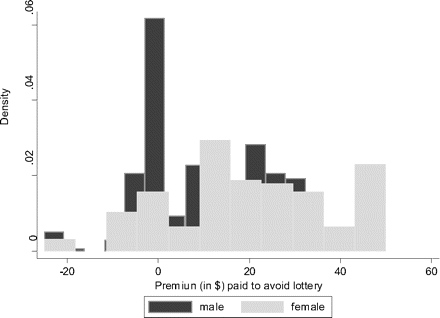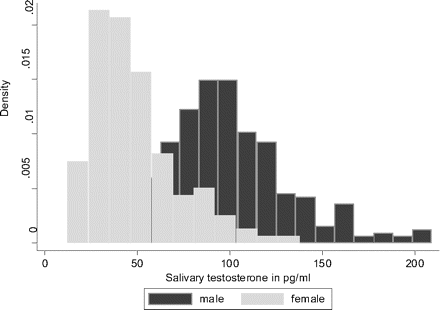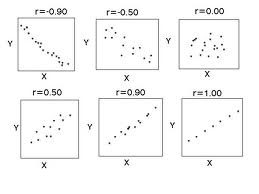Serendip is an independent site partnering with faculty at multiple colleges and universities around the world. Happy exploring!
Notes Towards Week 7 (Oct. 18): Naturalizing Culture -- Part III with Kaye
II. Kaye on hormones
In reading your posts, there seemed to be some resistance to Sullivan's claims that testosterone is a key element in gendered behavior:
lgleysteen: ...“The He Hormone” a frustrating yet intriguing article. I was surprised by how much the author attributed gender differences to biology instead of culture
aybala: I agree with lgleysteen that Sullivan is possibly putting too much emphasis on the effects of certain biological characteristics, rather than including societal and cultural pressures.
chelseam: I was frustrated by the ways Sullivan used biological differences to explain differences in the social roles men and women take on….I don’t disagree that hormonal levels change the ways we behave and perceive ourselves, but I wish that Sullivan more carefully considered the other elements that could be at play here.
sel209: ... I don't buy his final claims that this one particular hormone so drastically influences our conceptions of appropriate gender roles in society.
I may be overinterpreting these posts, but I wonder if they don't express a fear held by many others and most explicitly articulated by...
jfwright:….I cannot imagine a way to read this that doesn't have HUGE implications for supporting views of biological superiority of certain races and classes, and the inherent immorality of others. It implies that behavior is encoded in race and class, and that try as one might, their behavior is predetermined by their biology.
...a fear that that if gender and sexuality have biological determinants that they are predetermined, unchangeable--that it justifies sexism, aggression, homophobia--that society cannot change.
I would like to push back on those fears and speak as a biologist, as the coordinator of gender and sexuality studies, and as the mother of 3 sons.
What I hope to do in this next hour is to help you understand more fully how scientists study gendered behavior/cognition and what their data mean and don't mean, i.e., remind you of the topic for this section: De/Meaning of Sex and Gender.
As you know, science has cultural power in our society, and I believe that science has the potential to be a positive tool for social change. I'd like you to consider the radical possibility that biological determinants might be more readily changed than social determinants.
In my experience, too many gen/sex students and scholars have limited experience with science; they are not scientifically literate.
Consequently, I think it's worth our time to look more carefully not only at how scientific findings are expressed in popular media such as the New York Times, but also at the kinds of studies on hormonal effects on behavior that scientists are doing now.
We need a certain level of scientific literacy to recognize when the scientific data are weak so that we can challenge how they are being used to reinforce cultural stereotypes, as well as to recognize when scientific data are strong and need to be taken into consideration in our work for social change.
Beginning with Sullivan's article published in the New York Times in 2000:
"The He Hormone" provides anecdotal evidence that testosterone has physiological, behavioral, cognitive effects that our culture associates with maleness.
There are many such articles and ads in the popular press and on the web. One of the new developments that Sullivan highlights is the marketing of a topical testosterone gel. Here's the website for this product:
AndroGel AndroGel <You might want to take the quiz: Do you need testosterone?>
It's not just the media and corporations that claim that testosterone has physiological, behavioral, and cognitive effects, but also the medical community and the FDA, which warns about the mis-use of topical testosterone.
Warning from the AHFS (American Hospital Formulary Service) Consumer Information: http://www.ncbi.nlm.nih.gov/pubmedhealth/PMH0000303/#
- Testosterone gel may cause harmful effects to people who touch your skin in the area where you applied it. Women and children are especially likely to be affected if they touch skin that has been covered with testosterone gel. If a pregnant woman touches skin that has been covered with testosterone gel, her unborn baby may be harmed.
- Do not let anyone touch your skin in the area where you applied testosterone gel. If you expect that you may have skin-to-skin contact with another person, you should wash the area very well with soap and water. If anyone touches skin that has been covered with testosterone gel and has not been washed, that person should wash his or her skin with soap and water as soon as possible. You should also tell others to be careful when handling your clothing, bed linens, or other items that may have testosterone gel on them.
- If women or children touch skin that has been treated with testosterone gel, they may develop certain symptoms. If a woman who may have come into contact with testosterone gel develops either of the following symptoms, she should call her doctor immediately: growth of hair in new places on the body or acne. If a child who may have come into contact with testosterone gel develops any of the following system, you should call the child's doctor mediately: enlarged genitals, growth of pubic hair, increased erections, increased sexual desire, and aggressive behavior. Most of these symptoms can be expected to go away after the child stops coming into contact with testosterone gel, but in some cases, genitals may remain larger than normal.
- Testosterone gel may cause the bones to mature more quickly than normal in children who come into contact with the medication. This means that the children may stop growing sooner than expected and may have a shorter than expected adult height. Even if these children no longer come into contact with testosterone gel, their bones may remain more mature than normal.
There are many, many studies that convincingly show that testosterone has organizational and activational effects on behavior and cognition; there are others whose experimental protocols are not convincing or whose data do not reveal such effects.
- organizational: affects the development of brain structure and function (in utero and early childhood)
- activational: affects how a person responds to testosterone (measured after puberty)
Given that "The He Hormone" article was published 11 years ago and in the NYT, I want us to look at what is being published now in peer-reviewed scientific literature.
What are scientists studying about hormonal effects on behavior NOW?
What we're going to do is a close reading of a science article. Those of you majoring in literature are familiar with close readings of novels, so you might think about how a close reading of a scientific study is the same as and different from the close readings you have done in English courses.
What I'm doing is picking up on our discussion two weeks ago before fall break, when Anne asked us to think about how we write and how we read.
This is how I was taught in graduate school to read an article about a scientific experiment:
- Title, Authors, Abstract
- Materials and Methods
- Results = Data
- Draw my own conclusions
Let's try a close reading of the first article
Title:
Authors:
Abstract:
Materials and Methods:
- all 550 MBA students in the 2008 class at University of Chicago were asked to participate
- informed consent
- results from 140 women and 317 men were analyzed
How did the researchers conduct the experiments?
- tests done on two afternoons in Oct 2006
- salivary samples taken and analyzed for testosterone levels
- measured digit ratios: length of second and fourth fingers

 2D:4D Ratio-Here is why Obama is aggressive?
2D:4D Ratio-Here is why Obama is aggressive?- measured sociability and ability to empathize: "Reading the Mind in the Eyes"
- try the revised Baron-Cohen test
- risk aversion measured by giving participants a series of choices
- you can either enter a lottery in which you have an equal chance of winning $0 or $200
- OR
- you can accept a certain payment (ranging from $50-$120) outright
- where does each person draw the line?
- career choice what job (finance or non-finance) they accepted at graduation
What were the results (aka data)?

Fig. 1 (PNAS 106: 15269) Distribution of the $ premium a subject was willing to pay to avoid a 50/50 lottery that paid either $1 or $200. (This graph is easier to think about if you relabel the x-axis as the switch-over point--when will a person accept the certain payment rather than take a chance on the lottery, where s/he could get nothing or win more. In this case -20 = $120, 0 = $100, 20 = $80, 40 = $60. The far left end shows that it took $120 for at least a few males and a few females to not do the lottery. The far right end show that it only took $60 for some women, but no men, to not do the lottery.)

Fig. 2 (PNAS 106: 15269) Distribution of the concentrations of salivary testosterone in men and women.
But one of the questions is: does risk aversion (willingness to take certain money rather than try for more) correlate with testosterone levels?
The authors address this through statistical measures of correlation to determine whether an individual's testosterone level (independent variable) would help you predict his/her risk aversion (dependent variable).
One way of analyzing their data is to calculate the likelihood (probability) that lower testosterone levels are associated with higher risk aversion (will not play the lottery when offered even low sums of money to avoid it). To do this, they did regression analyses.
Basics of regression

r varies between -1 and +1, with 0 indicating no correlation
What their data show is an r = -0.1793 when examining testosterone levels in all 460 participants
What does this mean?
- a weak negative correlation such that the higher a person's testosterone was, the less risk averse s/he was (more likely to play the lottery)
The other measure to consider is statistical significance. What is the likelihood (probability) that their results were only due to random fluctuations in testosterone levels or measures of risk aversion?
Scientists calculate p (probability) which can range from 0 to 1; the lower the value, the less likely it is that the results are merely due to chance. p < 0.05 is commonly taken to be the cut-off point for statistically significance.
NB: As used in statistics, significant does not mean important or meaningful.
Some of the relationships that were and were not statistically significant at p < 0.05:
- testosterone levels and risk aversion for both genders
- testosterone levels and risk aversion for women but not for men
- "reading the mind in the eyes" but not the digit ratio and risk aversion for both genders
- "reading the mind in the eyes" but not the digit ratio and risk aversion for women but not for men
- risk aversion and career choice for both genders
Their conclusions were challenged (and responded) to in a later issue of PNAS:
"The risk of a wrong conclusion"
in groups of 4 (with at least one person who has taken statistics in high school or college):
- State the conclusions of the authors in your own words.
- Do you agree with any of the conclusions in the first paper?
- Why or why not?
Returning to the full group:
- What do you see as the risks of a wrong conclusion?
- Are the conclusions of the paper (that women are more risk averse than men) consistent with your experiences?
Thought it would be important for you to know:

National Academy of Sciences (NAS)
Established: 1863
Membership: Approximately 2,200 members 400 foreign associates
The National Academy of Sciences was established in 1863 to address the government's urgent need for an independent advisor on scientific matters. As science began to play an ever-increasing role in national priorities and public life, the National Academy of Sciences expanded to include the National Research Council in 1916, the National Academy of Engineering in 1964, and the Institute of Medicine in 1970.
Gender differences in majors, study abroad, cpgc internships, honors at Haverford College
(see powerpoint excerpt from presentation to Board Council for Women)
2. "Testosterone decreases trust in socially naive humans"
Differences in Materials and Methods between this study and the earlier one?
- overview by Ethics Committee
- smaller sample size, n = 24
- only women
- administered testosterone or placebo under the tongue
- measured trustworthiness using grayscale frontal pictures of unfamiliar faces
- asked whether subjects were more or less likely (or no change) to rate faces as trustworthy 4 hours after receiving testosterone

What can we learn about hormonal effects on behavior, about sexual differences, and about science from these two articles?
III. Anne again on intersexuality
| Attachment | Size |
|---|---|
| gendered majors_HC 2010.ppt | 484.5 KB |


